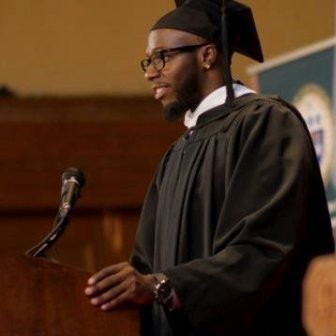Aswad Thomas was a recent college graduate headed to the European basketball leagues in 2009 when he was shot at eight times one night in Hartford, Conn. He was temporarily paralyzed with one bullet an inch away from his spine, had two collapsed lungs and extensive internal bleeding.

Aswad Thomas
By the time the 19-year-old suspect was tried, Thomas realized, "He was from the same community as me with high rates of gun violence.” Thomas had been raised in both inner-city Detroit, where he saw his grade-school best friend killed, and Hartford.
He learned that the suspect faced a 40-year prison sentence. With Thomas’ older brother in federal prison with a life sentence for a murder conviction, "I didn't want to put another person through that." He asked the prosecutor to work out a deal that allowed his attacker to plead guilty and get a sentence of six to 10 years.
Though his injuries ended his basketball career, his takeaway is that “young people of color are suffering from unaddressed trauma that [result] in further victimization.”
Today, Aswad Thomas, the membership director of Crime Survivors for Safety and Justice, helps release a major new report, “Smart, Safe and Fair,” that calls for alternative sentencing for violent offenders.
Solutions from crime victims
The key finding of the report, written by the Justice Policy Institute (JPI) and the National Center for Victims of Crime (NCVC): "The justice system currently treats youth charged with violent offenses in ways that are unnecessarily expensive, ineffective and unjust." It’s being unveiled today at NCVC's annual conference in Orlando, Fla.
In addition to traditional juvenile justice reform proposals, such as repealing the mandatory charging of juvenile felony offenders as adults, the report outlines fresh solutions shaped by the crime victims’ perspective:
- An approach that meets the needs of youth, strengthens families and addresses the underlying causes of crime.
- Greater use of community-based strategies for all youth who have engaged in crime, regardless of the offense type.
- The traumatic events that can lead to a youth being involved in violent crimes needs to be treated — a trauma-informed approach that would include everything from leniency in sentencing in considering a young person’s prior victimization to redirecting resources to fund more community-based mental health approaches.
One striking example in the report: Both violent and nonviolent offenders who went through a restorative justice program in Alameda County, Calif., that involved youth offender-victim dialogues and offender accountability had roughly comparable recidivism rates of just 18 percent. Sixty-two percent of them had been convicted of violent and nonviolent felony offenses.
Incarceration doesn’t work for violent offenders
For more information on Community-Based Alternatives, go to JJIE Resource Hub | Community-Based Alternatives
The 80-page report doesn’t cite specific recidivism rates for violent offenders alone, but aggregates a variety of studies that show community alternatives lower rearrests for all classes of offenders, repeated youth violence is relatively rare and that incarceration doesn’t work.
For instance, in California, nearly 74 percent of all incarcerated youth offenders get rearrested within three years of their release. Another analysis cited in the new report of a different population — 1,000 court-referred offenders, both violent and nonviolent — found that only 13 of them, 1.3 percent, engaged in multiple acts of violence once released.
This new report underscores its findings with an array of studies that also reinforces Thomas' hard-won belief that “more prisons and more jails don't make us safer or prevent crime, and there needs to be more investment in trauma recovery and helping stop the cycle of crime."
Although these principles are well-accepted for nonviolent offenders, the report emphasizes hopeful prospects for violent offenders, who have largely been bypassed in the recent consensus for using community-based alternative for juvenile offenders. JPI and NCVC say it also breaks new ground by joining the voices of the nation's largest crime victim organization with juvenile justice reformers.

Justice Policy Institute
Marc Schindler
"We're spending the bulk of our dollars on the least effective approach while not spending enough money on effective community-based programs," said Marc Schindler, JPI executive director. With average annual costs of youth incarceration in most states rising to $150,000, he said, and as high as $317,000 in some California localities, intensive outreach efforts such as the Los Angeles Police Department's Youth Advocacy Program cost as little as $70 a day, according to data cited in the report.
Mai Fernandez, NCVC executive director, said, "As a former prosecutor, I saw young people who needed help instead simply get incarcerated. We need to find a system that works for victims; one that simply punishes youth and provides neither accountability, nor safety for victims, just puts our communities in a worse position."
The report also flagged the fact that while there's been a drop in youth confined for nonviolent offenses of 70 percent nationally, violent offenders haven't benefited nearly as much: just a 54 percent decline over the same time frame. In one state-run facility in California, for example, 4 percent of the young people incarcerated were involved in a nonviolent offense, the report said.
This story has been updated.

Amen, It only makes sense. We can stop see the “other as monster and recognize our share humanity. Spending decsdes being abuse only compounds the anger when released. Public safety will be enhanced when early trauma is addressed. Inside snd outside the walls.
Mr Thomas, the admiration I’ve had for you has just doubled.
Pingback: Crime Victims Join Advocates to Urge Community Alternatives for Even Violent Offenders — Justice Policy Institute – Live Gossips